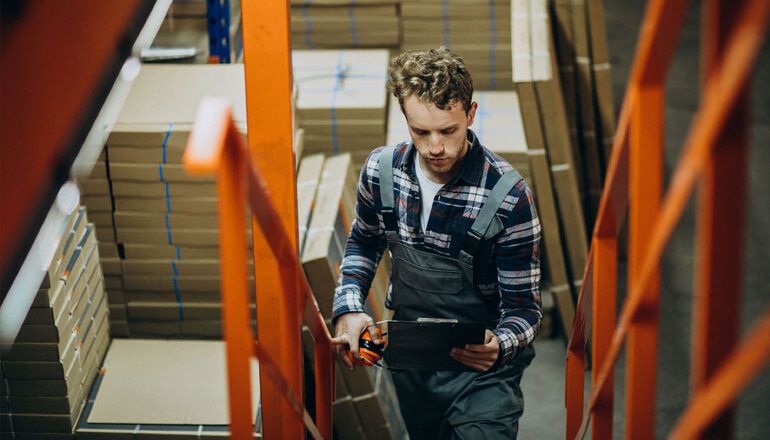A crucial part of the warehousing and shipping process is knowing how to pack your shipment properly. One simple packaging error could cause problems with bulk storage, expose your pallets to damage, and necessitate the need for pallet restacking, which takes even more time.
It is critical to start with high-quality materials when stacking pallets for transit or storage, which calls for the use of dependable plastic wrap and the avoidance of broken pallets. The strength and durability of the freight should be supported by the pallet packaging, so be sure to do so.
To put it simply, there is no “one size fits all” method for packaging your pallet for transit and unloading. But it does begin with some very fundamental best practices. The team at On Track Freight Systems has put together a thorough guide to packaging pallets for safe truck loading and unloading to assist you in getting started.
Let us examine the ideal methods for pallet stacking and restacking in more detail.
Why Should I Use a Pallet for My Freight?
If you choose to use a pallet for your freight, stability and protection will be added right away. Most frequently, pallets are used for extra security in small business shipments and freight that weighs more than 150 pounds. Using a pallet for your load facilitates loading and unloading and improves safety and efficiency. Additionally, there are many different pallet types that can be used for both shipping and storage in warehouses.
The most popular kind of pallet used for loads is a wooden pallet. The wooden pallet, whether for a truck or a trailer, has withstood the test of time and is demonstrated to reliably secure loads. Block pallets and stringer pallets are the two most common types of wooden pallets used for loads.
The Stringer Pallet Offers Excellent Support for Trailer Loads
Due to its use of three “stringers” to support shipments, the stringer pallet is so named. The boards known as stringers are positioned between the bottom and top deck boards and can be either 3x4s or 2x4s.
Although they can be used for 4-way forklift access, these kinds of pallets provide 2-way forklift access. It is simpler to load, store, and unload goods using stringer pallets because of their adaptable design.
Using the Block Pallet Can Be Timely, Efficient, and Reliable
Block pallets actually have four forklift entry points. In order to provide a dependable warehouse storage solution, they use a sturdy block of wood. Block pallets are able to hold anywhere between 4 and 12 blocks and are made to build extra-durable stacks.
Don’t stack Your Pallet! Use These Tips to Get It Right the First Time
As we already mentioned, there is no one-size-fits-all method for packing and stacking pallets for storage and deliveries. Whether you have one stack, two stacks, or more, use the following best practices to get it right the first time and avoid pallet restacking.
– Start with the Heaviest Goods First
The heaviest items should be loaded first by your team. Customers may be satisfied as a result of the stable base that is created and the avoidance of crushing less-dense or lighter goods. If necessary, think about using a pallet jack to safely lower the heaviest boxes and establish a sturdy base.
– Don’t Stack Your Load Over the Edge
If you want to make the most of every square inch of your pallet, it is best to arrange your boxes so that they are as close to the edge as you can get them without going over. Additionally, this makes strapping simpler and more secure. It is more likely that any boxes that hang over the pallet will undermine stability and result in damage. Furthermore, stacking boxes over the edge will probably necessitate restacking the pallet.
– Laying Boxes… Laying Bricks
Think of stacking the boxes in your load like you would laying bricks when doing so. The best way to do this is to use an overlapping shape or pattern that is frequently used in bricklaying. Always refrain from stacking boxes in columns if this is not possible. When being transported on trailers, this may make it simpler for boxes to slide and shift.
– Avoid the Pyramid Form for Your Freight
Smaller boxes should never be stacked near the top of the pallet, as is the mistake of many businesses. This results in the stack becoming pyramid-shaped as it grows taller and narrower. While pyramids may make for fantastic iconic images, if your customer receives damaged goods that have moved during transportation, they will not be happy. Instead, it’s best to work your smaller boxes into the stack to create a more cubic shape that is more stable.
– Strap Your Stack First, Then Stretch and wrap the Load
Always strap your pallet with strong bands before you begin stretching or shrink-wrapping your load. Use a high-quality stretch wrap or shrink wrap to protect your freight during warehousing and delivery after you have safely strapped the loaded boxes or items.
Can I Stack Pallets with a Pallet Jack?
Stacking pallets on top of each other is acceptable. However, if you are using the incorrect pallets, such as damaged pallets, it can be extremely risky. As a result, it is crucial that any damaged pallets be identified as such or only used with a freight forwarder who expressly forbids stacking pallets.
Contact CHP Logistics for Shipping Services
At CHP Logistics, we provide full truckload (FTL) shipping services, less-than-truckload (LTL) shipping services, and more at competitive prices. We have almost every size of trailer in stock, and we use cutting-edge technology to guarantee prompt delivery to the desired location.
Contact CHP Logistics today for the best freight shipping and logistics services.


